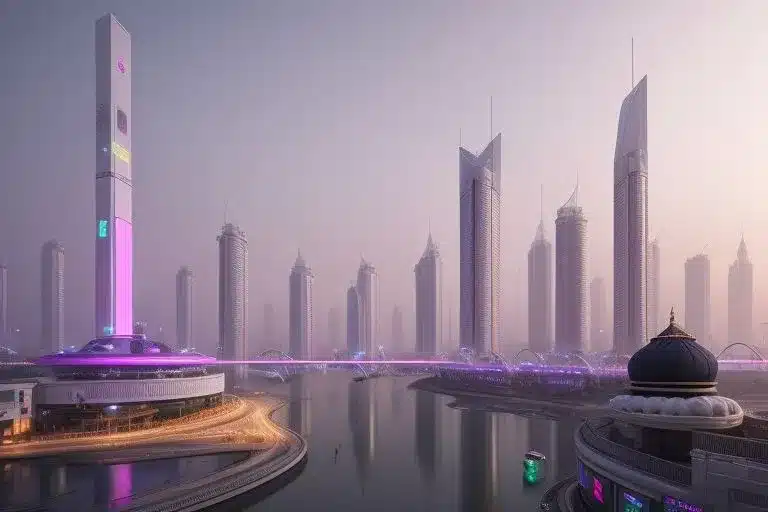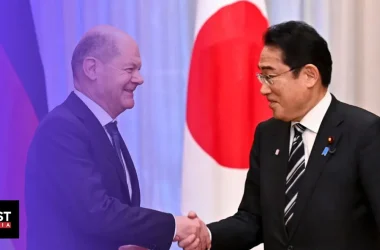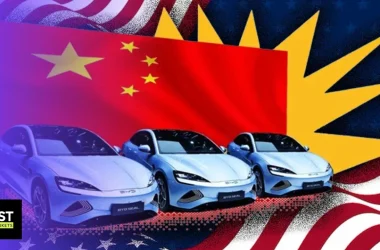India is investing hundreds of millions of dollars into its first operational smart city, GIFT City.
The smart city is an ambitious infrastructure project meant to rival financial powerhouses like Singapore, Hong Kong, London and New York, and become the new destination for fintech companies and startups.
It is already home to 400 companies, including international financial institutions like HSBC and JP Morgan while under construction, with the second phase of the project expected to be completed in 2030.
However, the city was described as active in the mornings but a complete ghost town by the evening, despite having more than 20,000 workers!
Still far away from achieving its dreams of creating a million jobs and building more than a thousand skyscrapers, GIFT City is facing troubles, including slow progress and a slow nightlife that is so uncharacteristic of a financial district.
With India’s history of infrastructure projects that ended in disaster, like the Chungthang dam, in mind, we wonder if GIFT City will become a success story, or will it be an unachievable dream?
What is GIFT City?
Gujarat International Finance Tec-City, popularly known as GIFT City, is a smart city and business district that is under construction in Gandhinagar district in Gujarat, India.
The city is India’s first operational smart city and international financial services center, and the Indian’s government’s vision for the city is to develop it into a global financial hub like Singapore, New York or London. As of June 2023, GIFT City is home to 23 international banks and financial institutions, including HSBC, Barclays and JP Morgan.
In addition to that, the city has 35 fintech companies and two international stock exchanges with average daily trading volumes of $30.6 billion. This isn’t all, the city is also home to India’s first ever international bullion exchange, with 75 jewelers given certificates of approval to import gold directly on the exchange. But, it’s not just a business city.
The smart city is currently being developed on an area of 3.6 square kilometers, it has a strategic and unique location as it falls between the state’s industrial capital Ahmedabad, and its political capital Gandhinagar, emphasizing the importance of connection between the three cities. Not only that, but it’s also a 20-minute drive from Ahmedabad’s international airport, making it easy to travel to and connect with the rest of the world.
Along with the business city, the Indian government shared plans to build a 5.76 square kilometers area that will include a commercial zone, accounting for 67% of the area, residential area that will be 22% and a social space that will be 11%.
GIFT City is meant to attract international businesses with global operations, including holding companies, and their executives as well. The Indian government is very keen on turning that dream into reality, so it began offering incentives for foreign investors and foreign companies that would join the city.
These incentives include a goods and services tax of zero, a 100% tax holiday on profits for 10 straight years for companies that register in the international financial services center, and allowing foreign investors to deal using the U.S. dollar, instead of the Indian rupee.
This investor-friendly approach paid off, and the international financial services center in Gift City took the first place on the Global Financial Centers Index in 2022 among the 15 global centers likely to gain importance in the next two to three years.
Currently, 16 buildings are standing in the city, and 27 extra buildings are under construction. Very recently, construction for the city’s first twisted tower was approved, and it’ll be built at the cost of around $84 million.
The twisted tower will be one of the city’s landmarks, and it’s especially exciting because it was designed by INI Design Studio, who designed Gateway Towers in Dubai and the Surat Diamond Bourse.
The city isn’t just committed to impressive infrastructure projects, but also to sustainability and environmentally-friendly practices. For instance, the city integrates green building designs, renewable energy sources, efficient water conservation measures and waste management systems.
If this smart city is successful, then India will be able to position itself as a global financial powerhouse. It is helped by its emphasis on connectivity and innovation, and its world-class infrastructure sets the stage for it to succeed in the future, and play an important role in India’s economic development.
How much of that is realistic?
The Indian government promoted the city as a global fintech hub that will rival Singapore or Hong Kong, but in reality, GIFT City is very different to these two.
Despite being home to more than 20,000 employees across 400 companies, the city becomes dead after work hours, when all employees rush home to nearby cities. This is a strange scene in a financial district.
Financial districts are always active, with finance professionals heading to the nearest bar or restaurant after work. Singapore and Hong Kong aside, India has business districts in Mumbai and that are just as busy.
GIFT City lacks sources of entertainment, and only has a few restaurants scattered around. There’s only one small Indian eatery near the Gift Towers 1 and 2, Sankalp Express, and it’s never busy, not even during lunch hours, according to its manager.
People who work and live in GIFT City found themselves having to go back and forth between the city and the nearby cities of Gandhinagar and Ahmedabad for every need, no matter how small or big.
Evidently, an employee in the Grand Mercure hotel in gift city said that supermarkets in the city only offer basic necessities like eggs and bread, and complained about how the city doesn’t have a mall or even a café.
Even though GIFT City is well-connected with Gandhinagar and Ahmedabad by modern electric buses, workers find having to travel to the larger cities for everything a tiring chore. In addition to that, many complained that the city has no place to hang out after work. All of this is turning GIFT City into a lifeless ghost town as soon as work hours end.
Another problem with GIFT City is its lack of residential areas, and that contributes to its “ghost town” reputation as well.
Despite starting with a walk-to-work concept, as in people who work in the city will have to live there and walk to work, only one residential project was completed, including houses for groups with lower incomes. So far, only 300 families live in GIFT City.
Therefore, the majority of GIFT City’s workforce live in the neighboring cities of Gandhinagar and Ahmedabad, and commute to work on private vehicles or office vans. Without a vehicle, commuting to GIFT City from the nearby cities is a struggle.
This isn’t the only issue with transportation. In fact, one problem is the frequency of public transport buses, which is coordinated with employees’ shift timings, making it hard for employees to stay for longer to wrap up some work or they’d miss their rides home. All of this is making the walk-to-home concept a far-fetched dream.
Government actions
Transportation issues in GIFT City don’t worry the Indian government that much, because it’s expecting that they’ll be a thing of the past once the construction on the metro line connecting GIFT City to Gandhinagar and Ahmedabad ends. The metro line is expected to be fully operational in 2024.
The government is focusing on making the city more active instead, or boosting the life in the city. Until 2021, only people who worked in GIFT City were allowed to live there and own homes. However, the government decided to welcome outsiders into the city, in order to boost sales and investments in the residency areas.
This encouraged construction groups like Sobha Limited, Kaavyaratna Group, and many others to take on a bunch of residential projects in the city. Like in any global financial hub, apartments and houses inside GIFT City will cost 30% to 40% more than those outside of the smart city area.
Along with residential areas, the government pledged to build schools, hospitals, hotels, clubs and provide many forms of entertainment in order to revive the city. For instance, GIFT City company expressed interest in developing art galleries, theaters, amusement parks, gaming zones and green spaces in September of this year.
India’s history with infrastructure failures
When talking about massive infrastructure projects like GIFT City, it’s important to mention that many Indian infrastructure projects end up failing, like Mizoram bridge that collapsed in August of this year, taking the lives of at least 26 migrant workers. Another unfortunate incident that happened recently in October, the collapse of the Chungthang dam on river Teesta, killed at least 94 people.
These aren’t the only infrastructure failures that led to tragic deaths in India. In fact, the repetition of these accidents has raised concerns over the safety standards in the construction of Indian megaprojects, and whether the country is actually qualified to complete megaprojects safely without errors.
The Indian government must stop its negligence towards the lives of the working class, especially migrant workers. In addition to that, it should remember that unorganized workers contribute to the country’s GDP by nearly 50%, yet only about 6% of them are covered by social security measures.
What does the future look like for GIFT City?
Even though it has its problems, GIFT City could still become a success story and contribute to India’s growth positively. We can’t deny the global interest in the city, and very recently, tech giants Google and Capgemini announced that they’d be setting up offices in the city.
In addition to that, Saudi Arabia’s investment minister said that the country could set up an office of its sovereign wealth fund in the Indian city during a visit to New Delhi in September.
However, it’ll most likely be years until we start seeing any sort of economic impact. The city’s development process is very slow; first conceived in 2007 with construction starting in 2012, it’s been a work in progress for more than a decade. The first phase of the city will be completed in 2025, and the second in 2030. This, along with the overall dull vibes of the city confirms that it still has a long way to go before it reaches Singapore or Dubai levels.
GIFT City is a daring idea that could have a lot to offer, but it needs a lot of work and support from the Indian government regarding filling infrastructure gaps. This project witnessed economic slowdowns caused by the 2008 subprime crisis, the Covid-19 pandemic, and the current global turmoil and geopolitical conflicts. Therefore, only time will tell how much enthusiasm India and the world still have for this project, and that will decide its future.
Disclaimer
Please visit and read our disclaimer here.









